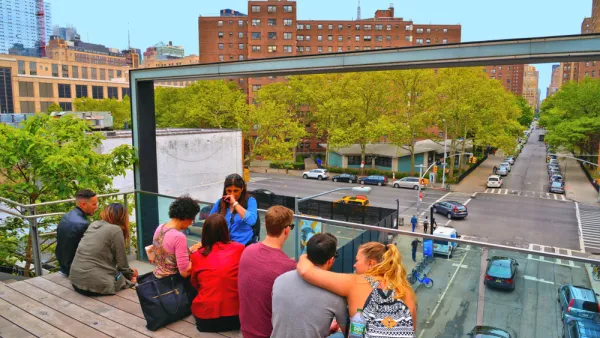Criticizes the idea that suburbanization has made Americans more libertarian.

I have written numerous articles (for example, here and here) asserting that sprawl is in large part a creation of government: government-built highways that encouraged migration to suburbia, government-built streets that were dangerous for pedestrians to cross, and zoning laws that enshrined automobile dependence by mandating single-use, low-density development with ample supplies of parking. Thus, suburbanites are just as dependent on government as urbanites: they drive on government-provided roads and park on government-mandated parking lots near government-widened streets, while the prestige of their communities depends on the prestige of government-provided schools.
But an acquaintance of mine raised an interesting counterargument He suggested that even if compact development does not in fact make people more dependent on government, it leads to a perception of dependence: people who live closer together think of themselves as part of a collective, while people who live in semi-rural surroundings think of themselves as rugged individualists. As a result, suburbanites are more likely to favor leaner government.
This argument does have some basis in reality: it is true that rural places tend to be more politically conservative than urban ones. But on the other hand, suburbanization does not seem to have created a more libertarian society. If this alleged libertarian psychology actually affected the growth of government, government would have gotten smaller as society suburbanized—especially in the late 20th century, when cities declined most rapidly. Older cities declined most rapidly in the 1960s and 1970s—but in those decades, federal outlays increased from 17.2 percent of gross national product (GNP) to 21.1 percent. State and local spending also increased (though somewhat more slowly, from 8.4 percent of GNP product to 9.5 percent). Since then, federal spending has remained flat, but state and local spending has continued to rise, to over 11 percent of GNP today. At the dawn of the suburban era in 1950, government at all levels consumed 22.4 percent of GNP; in 2014, that number was 31.7 percent.
It could be argued that even if suburbanization does not stop government growth, it does change politics—for example, one might trace the current ascendancy of Tea Party conservatism below the presidential level to the rise of suburbia. But at most levels of government, the conservative ascendancy began as urban decay has slowed. In the 1950s, at the dawn of the suburban era, Congress was politically competitive: the Republicans controlled both houses of Congress after the 1952 election, and came close to controlling the Senate later in the 1950s. By contrast, the Republicans did not control the House at all between 1954 and 1994, or even come close: 1956 was the last election where they won 200 seats(out of a possible 430 plus). Republicans did only slightly better in the Senate, controlling it for only 6 out of those 40 years (1980-86). In other words, the Golden Age of suburbanization was the Golden Age of American liberalism.
By contrast, the Republicans effectively became the majority party in 1994, as cities were beginning to recover: since their 1994 takeover of Congress they have controlled the House for all but 4 out of 22 years, and the Senate for the majority of years as well. Admittedly, the Republicans were dominant at the presidential level in the late 20th century—but (except for President Reagan) won only by nominating moderates such as Richard Nixon and the first President Bush. (By contrast, Republicans today tend to be more consistently conservative). In fact, Republican strength in suburbia has ebbed: over the past two decades, the Republicans have become a more rural and less suburban party. For example, Republicans once dominated Virginia's suburbs; today, the Northern Virginia suburbs lean Democratic, while rural areas are overwhelmingly Republican. So even in electoral politics, the link between the Right and the suburbs is not as strong as it once was.

Analysis: Cybertruck Fatality Rate Far Exceeds That of Ford Pinto
The Tesla Cybertruck was recalled seven times last year.

National Parks Layoffs Will Cause Communities to Lose Billions
Thousands of essential park workers were laid off this week, just before the busy spring break season.

Retro-silient?: America’s First “Eco-burb,” The Woodlands Turns 50
A master-planned community north of Houston offers lessons on green infrastructure and resilient design, but falls short of its founder’s lofty affordability and walkability goals.

Test News Post 1
This is a summary

Analysis: Cybertruck Fatality Rate Far Exceeds That of Ford Pinto
The Tesla Cybertruck was recalled seven times last year.

Test News Headline 46
Test for the image on the front page.
Urban Design for Planners 1: Software Tools
This six-course series explores essential urban design concepts using open source software and equips planners with the tools they need to participate fully in the urban design process.
Planning for Universal Design
Learn the tools for implementing Universal Design in planning regulations.
EMC Planning Group, Inc.
Planetizen
Planetizen
Mpact (formerly Rail~Volution)
Great Falls Development Authority, Inc.
HUDs Office of Policy Development and Research
NYU Wagner Graduate School of Public Service




























